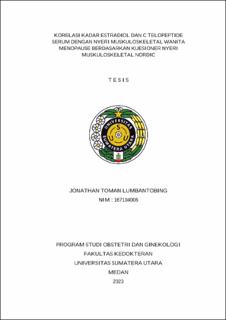| dc.contributor.advisor | Siregar, Muhammad Fidel Ganis | |
| dc.contributor.advisor | Pasaribu, Hotma Partogi | |
| dc.contributor.author | Lumbantobing, Jonathan Toman | |
| dc.date.accessioned | 2024-07-30T04:55:16Z | |
| dc.date.available | 2024-07-30T04:55:16Z | |
| dc.date.issued | 2023 | |
| dc.identifier.uri | https://repositori.usu.ac.id/handle/123456789/94578 | |
| dc.description.abstract | Background: Musculoskeletal pain is one of the common symptoms of menopause syndrome throughout the world. Estradiol is the most potent and abundant derivative of estrogen and is associated with musculoskeletal pain, stiffness, and depressed mood during the menopausal transition. C-telopeptide itself is a molecule released during osteoclastic bone resorption and degradation of type I collagen which is reported to have higher levels in individuals with musculoskeletal pain. Research regarding the relationship between estradiol and C telopeptide levels and musculoskeletal pain in menopausal women as measured by the Nordic Musculoskeletal Questionnaire (NMQ) has never been carried out before.
Objective: To determine the relationship between estradiol and C-telopeptide levels and musculoskeletal pain in menopausal women as measured by MENQOL (Menopause Quality of Life Questionnaire) and NMQ.
Methods: Observational analytical research with a cross-sectional design was used in this research. Estradiol and C-telopeptide levels were measured using the ELISA (Enzyme-linked Immunosorbent Assay) method in this study. Musculoskeletal pain was measured using the MENQOL and NMQ questionnaires. The data was then tested for normality using the Kolmogorov – Smirnov test. If the data is normally distributed then the hypothesis test uses the independent samples t-test and if the data is not normally distributed then the Mann-Whitney test is used. Apart from that, a correlation test was also carried out using the Pearson correlation test if the data was normal and the Spearman correlation test if the data was not normal.
Results: This study had a mean of research subjects of 57.41 years with the majority of subjects aged ≥ 50 years (93.7%), suffering from obesity (59.4%), and multiparous (71.9%). There was no significant relationship found between estradiol levels and C-telopeptide levels and musculoskeletal pain based on the NMQ questionnaire (p>0.05). There was no significant relationship found between estradiol levels and C-telopeptide levels and musculoskeletal pain based on the MENQOL questionnaire (p>0.05). In the Spearman correlation test, there was no correlation between estradiol levels and serum C-telopeptide levels (p=0.103).
Conclusion: There is no significant relationship between estradiol levels and C-telopeptide levels and musculoskeletal pain using either the NMQ or MENQOL questionnaires. There was also no correlation between estradiol levels and serum C-telopeptide levels in menopausal women | en_US |
| dc.language.iso | id | en_US |
| dc.publisher | Universitas Sumatera Utara | en_US |
| dc.subject | Estradiol levels | en_US |
| dc.subject | C-telopeptide levels | en_US |
| dc.subject | Nordic Musculoskeletal Questionnaire | en_US |
| dc.subject | musculoskeletal pain | en_US |
| dc.subject | Menopause Quality of Life Questionnaire | en_US |
| dc.subject | SDGs | en_US |
| dc.title | Korelasi Kadar Estradiol dan C Telopeptide Serum dengan Nyeri Muskuloskeletal Wanita Menopause Berdasarkan Kuesioner Nyeri Muskuloskeletal Nordic | en_US |
| dc.title.alternative | Correlation of Serum Estradiol and C-Telopeptide Levels with Musculoskeletal Pain in Menopause Women Based on The Nordic Musculoskeletal Pain Questionnaire | en_US |
| dc.type | Thesis | en_US |
| dc.identifier.nim | NIM167104006 | |
| dc.identifier.nidn | NIDN0030056407 | |
| dc.identifier.nidn | NIDN0016016006 | |
| dc.identifier.kodeprodi | KODEPRODI11716#Obstetri dan Ginekologi | |
| dc.description.pages | 85 Pages | en_US |
| dc.description.type | Tesis Magister | en_US |


